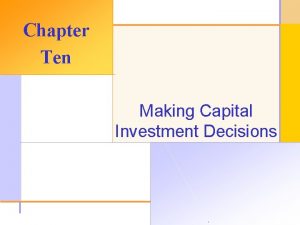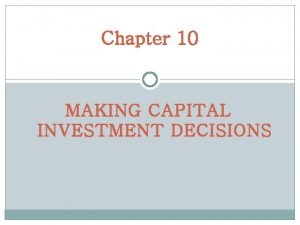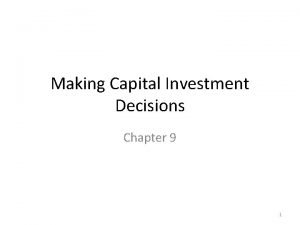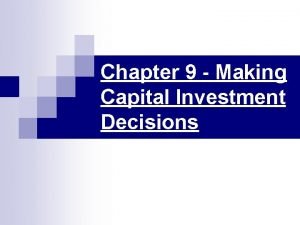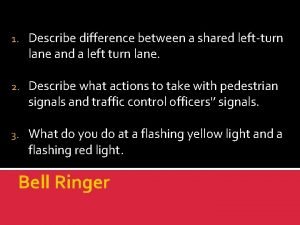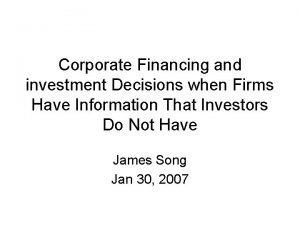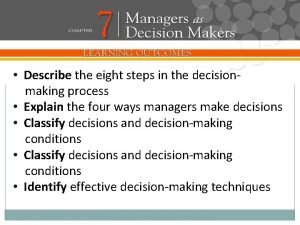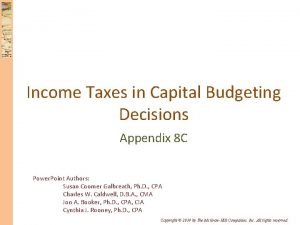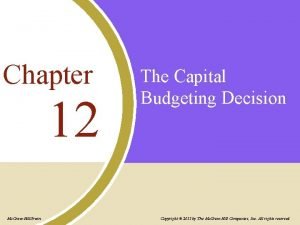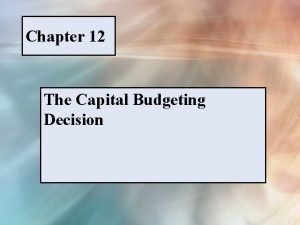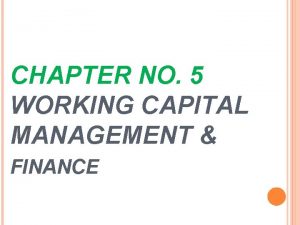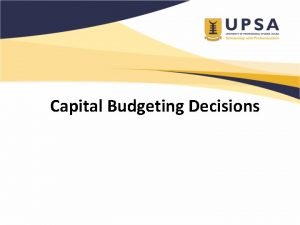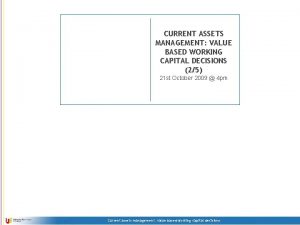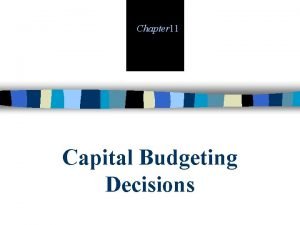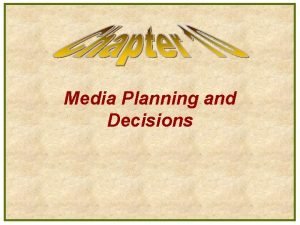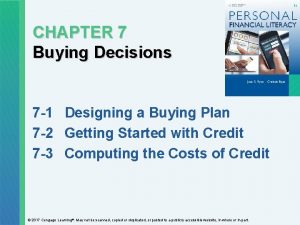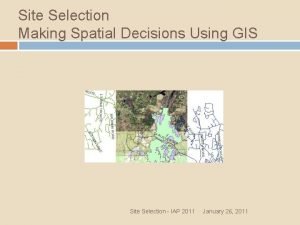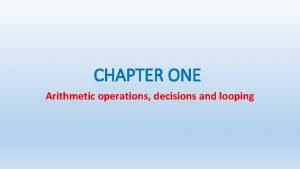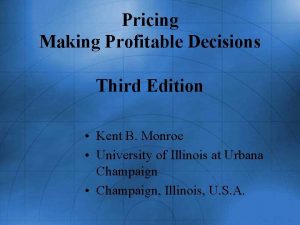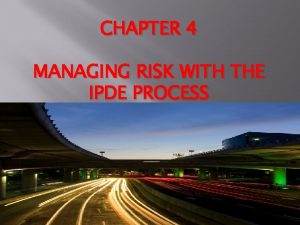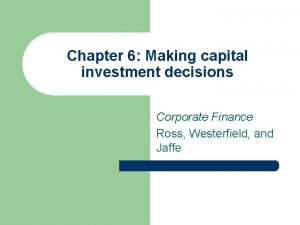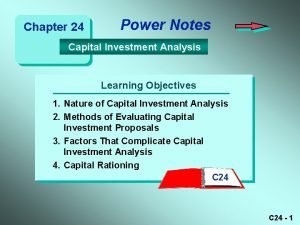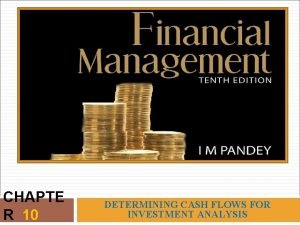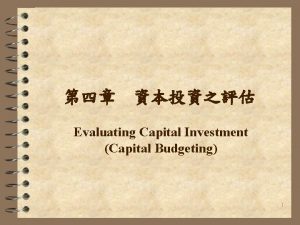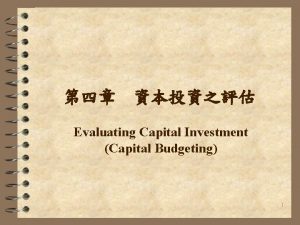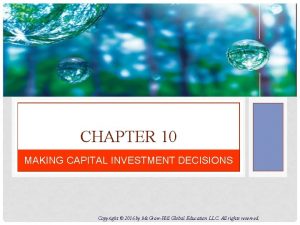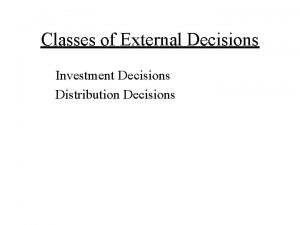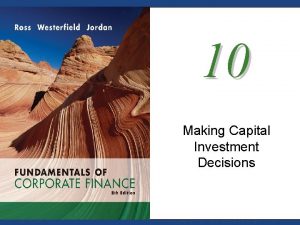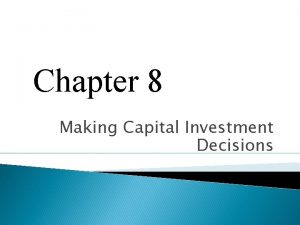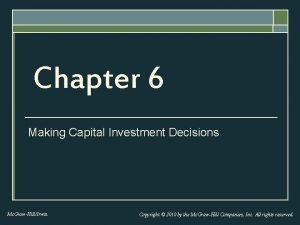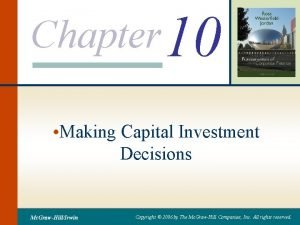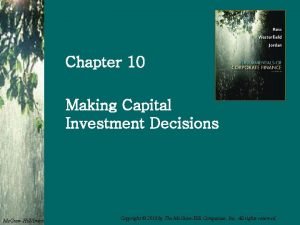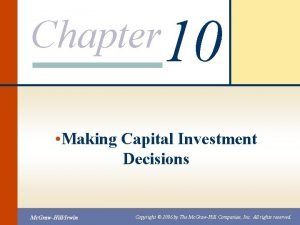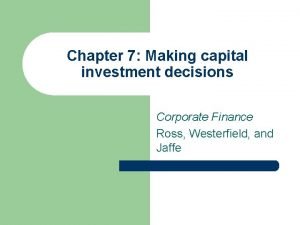CHAPTER EIGHT Making capital investment decisions Copyright 2017






































- Slides: 38

CHAPTER EIGHT Making capital investment decisions Copyright © 2017 Mc. Graw-Hill Education (Australia) Pty Ltd PPTs to accompany Fundamentals of Corporate Finance 7 e by Ross et al. 2 -1

Learning objectives LO 8. 1 Understand how to determine the relevant cash flows for a proposed project. LO 8. 2 Understand how to determine if a project is acceptable. LO 8. 3 Understand how to set a bid price for a project. LO 8. 4 Understand how to evaluate the equivalent annual cost of a project. Copyright © 2017 Mc. Graw-Hill Education (Australia) Pty Ltd PPTs to accompany Fundamentals of Corporate Finance 7 e by Ross et al. 2 -2

Chapter organisation • • • Project cash flows: a first look Incremental cash flows Project cash flows More on project cash flows Some special cases of discounted cash flow analysis • Summary and conclusions Copyright © 2017 Mc. Graw-Hill Education (Australia) Pty Ltd PPTs to accompany Fundamentals of Corporate Finance 7 e by Ross et al. 2 -3

Project cash flows • The incremental cash flows for project evaluation consist of any and all changes in the firm’s future cash flows that are a direct consequence of undertaking the project. • The stand-alone principle is the evaluation of a project based on the project’s incremental cash flows. Copyright © 2017 Mc. Graw-Hill Education (Australia) Pty Ltd PPTs to accompany Fundamentals of Corporate Finance 7 e by Ross et al. 2 -4

Types of cash flows • Sunk costs a cost that has already been incurred and cannot be removed incremental cash flow. • Opportunity costs the most valuable alternative that is given up if a particular investment is undertaken = incremental cash flow. • Side effects erosion the cash flows of a new project that come at the expense of a firm’s existing projects = incremental cash continued flow. Copyright © 2017 Mc. Graw-Hill Education (Australia) Pty Ltd PPTs to accompany Fundamentals of Corporate Finance 7 e by Ross et al. 2 -5

Types of cash flows • Financing costs the interest rate used to discount the cash flows reflects, in part, the financing costs of the project incremental cash flow. • An investment of the firm in the project’s net working capital represents an additional cost of undertaking the investment. • Always use after-tax incremental cash flow, since taxes are definitely a cash flow. Copyright © 2017 Mc. Graw-Hill Education (Australia) Pty Ltd PPTs to accompany Fundamentals of Corporate Finance 7 e by Ross et al. 2 -6

Investment evaluation Step 1 Calculate the tax effect of the decision. Step 2 Calculate the cash flows relevant to the decision. Step 3 Discount the cash flows to make the decision. Copyright © 2017 Mc. Graw-Hill Education (Australia) Pty Ltd PPTs to accompany Fundamentals of Corporate Finance 7 e by Ross et al. 2 -7

Example—Investment evaluation • Purchase price $42 000. • Salvage value $1 000 at end of Year 3. • Net cash flows: Year 1 $31 000 Year 2 $25 000 Year 3 $20 000. • Tax rate is 30%. • Depreciation 20%, reducing balance. • Required rate of return 12%. Copyright © 2017 Mc. Graw-Hill Education (Australia) Pty Ltd PPTs to accompany Fundamentals of Corporate Finance 7 e by Ross et al. 2 -8

Solution—Depreciation schedule Copyright © 2017 Mc. Graw-Hill Education (Australia) Pty Ltd PPTs to accompany Fundamentals of Corporate Finance 7 e by Ross et al. 2 -9

Solution—Taxable income Year 0 Net cash flows Depreciation Loss on sale Taxable income Year 1 31 000 (8 400) Year 3 20 000 (5 376) (20 504) $22 600 $18 280 $(5 880) Copyright © 2017 Mc. Graw-Hill Education (Australia) Pty Ltd PPTs to accompany Fundamentals of Corporate Finance 7 e by Ross et al. Year 2 25 000 (6 720) 2 -10

Solution—Cash flows Year 0 Year 1 Year 2 Year 3 Tax paid (6 780) (5 484) 1 764 Net cash flow 31 000 25 000 20 000 Salvage value Outlay Cash flow 1 000 (42 000) $24 220 Copyright © 2017 Mc. Graw-Hill Education (Australia) Pty Ltd PPTs to accompany Fundamentals of Corporate Finance 7 e by Ross et al. $19 516 $22 764 2 -11

Solution—NPV and decision Cash flow Discount PV cash flow NPV Year 0 Year 1 Year 2 Year 3 (42 000) 1 ($42 000) 24 220 0. 8929 $21 626 19 516 0. 7972 $15 558 22 764 0. 7118 $16 203 $11 387 Decision: NPV > 0, therefore, ACCEPT. Copyright © 2017 Mc. Graw-Hill Education (Australia) Pty Ltd PPTs to accompany Fundamentals of Corporate Finance 7 e by Ross et al. 2 -12

Interest • As the project’s NPV is positive, the cash flows from the investment will cover interest costs (as long as the interest cost is less than the required rate of return). • Interest costs should not, therefore, be included as an explicit cash flow. • Interest costs are included in the required rate of return (discount rate) used to evaluate the project. Copyright © 2017 Mc. Graw-Hill Education (Australia) Pty Ltd PPTs to accompany Fundamentals of Corporate Finance 7 e by Ross et al. 2 -13

Depreciation • The depreciation expense used for capital budgeting should be the depreciation schedule required for tax purposes. • Depreciation is a non-cash expense; consequently, it is only relevant because it affects taxes. continued Copyright © 2017 Mc. Graw-Hill Education (Australia) Pty Ltd PPTs to accompany Fundamentals of Corporate Finance 7 e by Ross et al. 2 -14

Depreciation • There are two methods of depreciation: – prime cost (straight-line method in accounting) – diminishing value (reducing balance method in accounting) • Depreciation tax shield = DT where D = depreciation expense T = marginal tax rate. Copyright © 2017 Mc. Graw-Hill Education (Australia) Pty Ltd PPTs to accompany Fundamentals of Corporate Finance 7 e by Ross et al. 2 -15

Disposal of assets • If the salvage value > book value, a gain is made on disposal. This gain is subject to tax (excess depreciation in previous periods). • If the salvage value < book value, the ensuing loss on disposal is a tax deduction (insufficient depreciation in previous periods). Copyright © 2017 Mc. Graw-Hill Education (Australia) Pty Ltd PPTs to accompany Fundamentals of Corporate Finance 7 e by Ross et al. 2 -16

Capital gains tax • Capital gains made on the sale of assets such as rental property are subject to taxation. • For taxation purposes, the calculation of a capital gain is complicated and depends upon whether the seller is an individual or an entity, such as a company or trust. • Capital losses are not a tax deduction but can be offset against future capital gains. Copyright © 2017 Mc. Graw-Hill Education (Australia) Pty Ltd PPTs to accompany Fundamentals of Corporate Finance 7 e by Ross et al. 2 -17

Inflation • When a project is being evaluated, anticipated inflation would be reflected in the estimates of the future cash flows and the interest rate used as the discount rate in the analysis. • As a result, there will be no distortion to the analysis by not identifying inflation specifically. Copyright © 2017 Mc. Graw-Hill Education (Australia) Pty Ltd PPTs to accompany Fundamentals of Corporate Finance 7 e by Ross et al. 2 -18

Incremental form of analysis • The description ‘incremental’ is often replaced by ‘marginal’. • The advantage of using a marginal form of analysis is that there will only be one calculation and not two. • By using a marginal form we are implicitly analysing one option: that is, to do nothing. • The sign of the NPV tells us whether or not it is sensible to change. Copyright © 2017 Mc. Graw-Hill Education (Australia) Pty Ltd PPTs to accompany Fundamentals of Corporate Finance 7 e by Ross et al. 2 -19

Example—Incremental cash flows A firm is currently considering replacing a machine purchased two years ago, with an original estimated useful life of five years. The replacement machine has an economic life of three years. Other relevant data is summarised below: Initial cost Annual revenues Annual costs Annual depreciation Salvage value Tax rate Required rate of return Existing machine $240 000 $100 000 $60 000 $48 000 $80 000 (Now) 30% 10% Copyright © 2017 Mc. Graw-Hill Education (Australia) Pty Ltd PPTs to accompany Fundamentals of Corporate Finance 7 e by Ross et al. New machine $360 000 $150 000 $70 000 $120 000 $100 000 (End year 3) 2 -20

Solution—Taxable income Year 0 Increased revenues Increased costs Dep’n existing Dep’n new Loss on sale (existing) Gain on sale (new) Taxable income Year 1 Year 2 Year 3 50 000 (10 000) 48 000 (120 000) $(32 000) 100 000 $68 000 (64 000) $(32 000) Copyright © 2017 Mc. Graw-Hill Education (Australia) Pty Ltd PPTs to accompany Fundamentals of Corporate Finance 7 e by Ross et al. 2 -21

Solution—Cash flows Tax Increased revenues Increased costs Salvage values Outlay Cash flow Year 0 19 200 80 000 (360 000) $(260 800) Year 1 9 600 50 000 Year 2 9 600 50 000 Year 3 (20 400) 50 000 (10 000) 100 000 $49 600 $160 400 Copyright © 2017 Mc. Graw-Hill Education (Australia) Pty Ltd PPTs to accompany Fundamentals of Corporate Finance 7 e by Ross et al. 2 -22

Solution—NPV and decision Year 0 Cash flow (260 800) Discount 1 PV of cash $(260 800) flow NPV ($54 212) Year 1 49 600 0. 9091 $45 091 Year 2 49 600 0. 8264 $40 989 Year 3 160 400 0. 7513 $120 508 Decision: NPV < 0, therefore, REJECT. Copyright © 2017 Mc. Graw-Hill Education (Australia) Pty Ltd PPTs to accompany Fundamentals of Corporate Finance 7 e by Ross et al. 2 -23

A note on cash flows • Cash flows do not always conveniently occur at the end of the period. • Taking revenue at the period end is a conservative approach to evaluation. • If the facts make it necessary to take cash flows as occurring at the beginning of the period, this only requires a minor adjustment to the analysis. • The period examined could be yearly, monthly or even weekly. If so, the discount rate must match the period (e. g. a weekly analysis needs a weekly rate). Copyright © 2017 Mc. Graw-Hill Education (Australia) Pty Ltd PPTs to accompany Fundamentals of Corporate Finance 7 e by Ross et al. 2 -24

Setting the bid price • How to set the lowest price that can be profitably charged. • Cash outflows are given. • Determine cash inflows that result in zero NPV at the required rate of return. • From cash inflows, calculate sales revenue and price per unit. Copyright © 2017 Mc. Graw-Hill Education (Australia) Pty Ltd PPTs to accompany Fundamentals of Corporate Finance 7 e by Ross et al. 2 -25

Example—Setting the bid price • Consider the following information: – A local distributor has requested bid for 5 trucks each year for the next 4 years. – You can buy a truck for $12 000. – Need to lease a factory space for $30 000 per year. – Labour and material costs are $ 6 000 per year. – Requires $72 000 in fixed assets (initial outlay) with expected salvage of $5 000 at the end of the project (depreciate straight-line). – Tax rate = 30% continued – Required return = 20% Copyright © 2017 Mc. Graw-Hill Education (Australia) Pty Ltd PPTs to accompany Fundamentals of Corporate Finance 7 e by Ross et al. 2 -26

Example—Setting the bid price Solution: • Step 1: Find the net initial outlay Fixed assets Less the PV of after tax salvage [5 000(1 -0. 3)/(1+0. 2)4 Net Initial investment 72, 000. 00 1, 687. 89 70, 312. 11 • Step 2: Find the cash inflows (CFs) over the life of the project that makes NPV zero. continued Copyright © 2017 Mc. Graw-Hill Education (Australia) Pty Ltd PPTs to accompany Fundamentals of Corporate Finance 7 e by Ross et al. 2 -27

Example—Setting the bid price • Assuming that the CF is the same for each year and that it occur at the end of each year, we can write: continued Copyright © 2017 Mc. Graw-Hill Education (Australia) Pty Ltd PPTs to accompany Fundamentals of Corporate Finance 7 e by Ross et al. 2 -28

Example—Setting the bid price • Step 3: Find the sale price that gives a cash inflow of $27 161 per year. Cash inflow = Profit + Depreciation $27 161 = Profit + ($72 000/4) Profit = $27 161 − $18 000 = $9 161 We know: Profit = (Sales − Costs − Depreciation)(1 − TC) Sales = $9 161/0. 70 + $120 000 + $18 000 = $151 087 Sales per truck = $151 087 / 5 = $30 218 Copyright © 2017 Mc. Graw-Hill Education (Australia) Pty Ltd PPTs to accompany Fundamentals of Corporate Finance 7 e by Ross et al. 2 -29

Setting the option value • A buy option is an arrangement that gives the holder the right to buy an asset at a fixed price sometime in the future. Option value = Asset value × Probability of the value – Present value of the exercise price × Probability the exercise price will be paid Copyright © 2017 Mc. Graw-Hill Education (Australia) Pty Ltd PPTs to accompany Fundamentals of Corporate Finance 7 e by Ross et al. 2 -30

Annual equivalent cost (AEC) • When comparing two mutually-exclusive projects with different lives, it is necessary to make comparisons over the same time period. • AEC is the present value of each project’s costs calculated on an annual basis. • NPVs are calculated, and then converted to AECs using the relevant PVIFA (present value interest factor for annuities). • Select the project with the lowest AEC. Copyright © 2017 Mc. Graw-Hill Education (Australia) Pty Ltd PPTs to accompany Fundamentals of Corporate Finance 7 e by Ross et al. 2 -31

Example—AEC • Project A costs $3 000, and then $1 000 per annum for the next four years. • Project B costs $6 000, and then $1 200 for the next eight years. • Required rate of return for both projects is 10 per cent. • Which is the better project? Copyright © 2017 Mc. Graw-Hill Education (Australia) Pty Ltd PPTs to accompany Fundamentals of Corporate Finance 7 e by Ross et al. 2 -32

Solution—Project A Copyright © 2017 Mc. Graw-Hill Education (Australia) Pty Ltd PPTs to accompany Fundamentals of Corporate Finance 7 e by Ross et al. 2 -33

Solution—Project B Copyright © 2017 Mc. Graw-Hill Education (Australia) Pty Ltd PPTs to accompany Fundamentals of Corporate Finance 7 e by Ross et al. 2 -34

Solution—Interpretation ‘Project A is better, because it costs $1 946 per year compared to Project B’s $2 325 per year’. Copyright © 2017 Mc. Graw-Hill Education (Australia) Pty Ltd PPTs to accompany Fundamentals of Corporate Finance 7 e by Ross et al. 2 -35

Annual equivalent benefit (AEB) • The AEB is used when comparing projects with cash inflows and outflows, but with unequal lives. • The steps required to calculate the AEB are the same as those used for AEC. • Select the project with the highest AEB. Copyright © 2017 Mc. Graw-Hill Education (Australia) Pty Ltd PPTs to accompany Fundamentals of Corporate Finance 7 e by Ross et al. 2 -36

Quick quiz • How do we determine if cash flows are relevant to the capital budgeting decision? • What are the different methods for computing operating cash flow, and when are they important? • What is the basic process for finding the bid price? • What is equivalent annual cost, and when should it be used? Copyright © 2017 Mc. Graw-Hill Education (Australia) Pty Ltd PPTs to accompany Fundamentals of Corporate Finance 7 e by Ross et al. 2 -37

Summary and conclusions • Discounted cash flow (DCF) analysis is a standard tool in the business world. • The information provided for a specific decision may be complex; however, the analysis reduces to three distinct steps: Step 1 Calculate the taxable income Step 2 Calculate the cash flows relevant to the decision Step 3 Discount the cash flows to make the decision. • Cash flows should be identified in a way that makes economic sense. Copyright © 2017 Mc. Graw-Hill Education (Australia) Pty Ltd PPTs to accompany Fundamentals of Corporate Finance 7 e by Ross et al. 2 -38
 Cca tax shield formula
Cca tax shield formula Chapter 10 making capital investment decisions
Chapter 10 making capital investment decisions Making capital investment decisions
Making capital investment decisions Making capital investment decisions
Making capital investment decisions Making capital investment decisions
Making capital investment decisions Poster making meaning
Poster making meaning Plane figures and solid figures
Plane figures and solid figures What are the meanings of the eight shapes and eight colors
What are the meanings of the eight shapes and eight colors Screening decisions and preference decisions
Screening decisions and preference decisions Pecking order theory
Pecking order theory Copyright secondary sara (2017) answers
Copyright secondary sara (2017) answers Fixed investment and inventory investment
Fixed investment and inventory investment 8 steps decision making process example management
8 steps decision making process example management Tax shield
Tax shield Advantages of capital budgeting
Advantages of capital budgeting Capital budgeting decisions ppt
Capital budgeting decisions ppt Operating cycle method
Operating cycle method Nature of capital budgeting decisions
Nature of capital budgeting decisions Working capital decisions
Working capital decisions Capital budgeting decisions include
Capital budgeting decisions include Payback chapter 14
Payback chapter 14 Media decision
Media decision Chapter 7 buying decisions
Chapter 7 buying decisions Chapter 7 buying decisions
Chapter 7 buying decisions Making spatial decisions using gis
Making spatial decisions using gis Making healthy decisions unit test
Making healthy decisions unit test Setting health goals and making responsible decisions
Setting health goals and making responsible decisions Arithmetic sequence in making decisions
Arithmetic sequence in making decisions Pricing: making profitable decisions
Pricing: making profitable decisions Be wise in every decision you make
Be wise in every decision you make To compromise space means to
To compromise space means to Lesson 2 making responsible decisions and setting goals
Lesson 2 making responsible decisions and setting goals Larry and peggy are making decisions
Larry and peggy are making decisions Lesson 2 making responsible decisions and setting goals
Lesson 2 making responsible decisions and setting goals Making connections analyzing presidential decisions
Making connections analyzing presidential decisions Explain what is meant by selective use of the ipde process
Explain what is meant by selective use of the ipde process Working capital investment example
Working capital investment example Factors that complicate capital investment analysis
Factors that complicate capital investment analysis Working capital investment example
Working capital investment example
